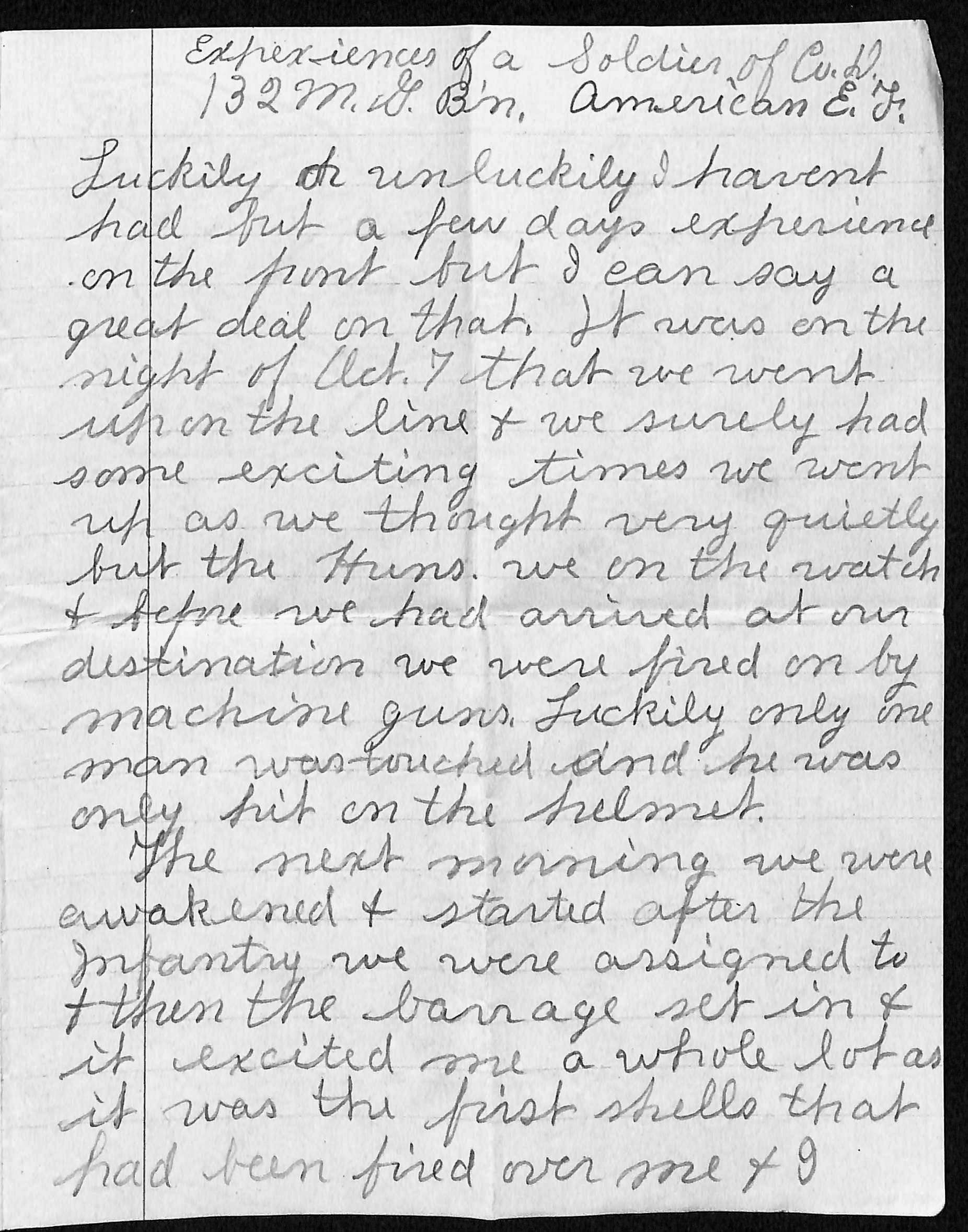WWI Experience of Cpl. Eugene S. McLain
1918
Add to Favorites:
Add all page(s) of this document to activity:

Add only page 1 to activity:
Add only page 2 to activity:
Add only page 3 to activity:
In this World War I account, Corporal Eugene McLain describes parts of the war as "exciting." He was glad he had the experience, but was "also glad when it ended. Because honestly it is Hell."
This document comes from a collection of "Personal War Experiences" that WWI servicemen were asked to write after their return from the front during the Meuse-Argonne Offensive. The men were personnel of the 36th Division – known as the Lone Star Division, formed from the Texas and Oklahoma National Guard – of the American Expeditionary Forces (AEF).
Corporal McLain's account includes derogatory terms used more frequently at that time. He calls German soldiers "Huns," and refers to his American Indian comrades as "redskins." He wrote "...Believe me those redskins didn't have any mercy on them." McLain was referring to Company E of the 36th Division, which fought alongside Company D (to which Corporal McLain belonged). During WWI, American Indians were integrated into numerous divisions of the AEF. A few units, however – like Company E of the 36th Division – were all American Indian. More than 12,000 American Indians served in the armed forces of the United States during WWI. In the army, their many roles included serving as gunners, snipers, patrol workers, messengers, scouts, medical personnel, radio operators, as well as code talkers.
This document comes from a collection of "Personal War Experiences" that WWI servicemen were asked to write after their return from the front during the Meuse-Argonne Offensive. The men were personnel of the 36th Division – known as the Lone Star Division, formed from the Texas and Oklahoma National Guard – of the American Expeditionary Forces (AEF).
Corporal McLain's account includes derogatory terms used more frequently at that time. He calls German soldiers "Huns," and refers to his American Indian comrades as "redskins." He wrote "...Believe me those redskins didn't have any mercy on them." McLain was referring to Company E of the 36th Division, which fought alongside Company D (to which Corporal McLain belonged). During WWI, American Indians were integrated into numerous divisions of the AEF. A few units, however – like Company E of the 36th Division – were all American Indian. More than 12,000 American Indians served in the armed forces of the United States during WWI. In the army, their many roles included serving as gunners, snipers, patrol workers, messengers, scouts, medical personnel, radio operators, as well as code talkers.
Transcript
Experiences of a Soldier of Co. D.132 M.G. Bn. American E.F.
Luckily or unluckily I haven't had but a few days experience on the front but I can say a great deal on that. It was on the night of Oct. 7 that we went up on the line & we surely had some exciting times we went up as we thought very quietly but the Huns were on the watch & before we had arrived at our destination we were fired on by machine guns. Luckily only one man was touched and he was only hit on the helmet.
The next morning we were awakened & started after the Infantry we were assigned to & then the barrage set in & it excited me a whole lot as it was the first shells that had been fired over me & I
couldn't tell if they were Bosh or not. But it didn't take me long to tell the difference when a J.I. can hit close to me.
Well we advanced over the hill & the Infantry came in contact with some Huns. & Believe me those redskins didn't have any mercy on them. After taking up our positions we stayed thru 2 or 3 days.
On Oct. 11 the 72 brigade went over & the formation was excellent in the sector I could see. & They went several kilometers before they stopped. In the afternoon we begin to follow. & It is nice to look at the way those Germans were dug in & the way they were fixed.
Then we hiked 2 days & one night & had a day or 2 rest. Plenty eats & felt rather like taking too them again. But we never got the chance for some days.
Well we stayed around on the line untill Oct 27 & another drive was made. Luckily I was where I could see all & It was rather exciting untill some Hun across the river decided to fire a few barrels & he kept me down untill it was over & then some.
Well I am glad it is over because when a six inch shell bursts about 10 ft. from you it sounds like a 14 in. & It really excites a fellow.
I am glad I have had the experience & also glad it is finish. Because honestly it is Hell.
Eugene S. McLain.
This primary source comes from the Records of the American Expeditionary Forces (World War I), 1848 - 1942.
National Archives Identifier: 77417784
Full Citation: Personal Experience of World War I from Cpl. Eugene S. McLain; 1918; McLain Eugene S. Cpl. 132nd M.G. Bn. CO. D 36th Division 1918, 236.33.61; Records of Divisions, 1917 - 1920; Records of the American Expeditionary Forces (World War I), 1848 - 1942, Record Group 120; National Archives at College Park, College Park, MD. [Online Version, https://www.docsteach.org/documents/document/wwi-mclain, April 26, 2024]Activities that use this document
- New Technology in World War I
Created by the National Archives Education Team
Rights: Public Domain, Free of Known Copyright Restrictions. Learn more on our privacy and legal page.






